There’s always been something almost mystical about camellias which makes people fall under their spell. And, like rhododendron and Japanese maple lovers; enthusiasts go all starry-eyed and wistful at the very mention of their name. Perhaps it’s their exotic Far East pedigree that captivates hearts, but originating in a corner of the world loosely strung out between Nepal, Vietnam, Japan and Korea – they grow in a very unglamorous climate. With Britain’s four distinct seasons – much the same as large chunks of Europe – they suffer sun, rain and snow, much as we do, and that is why they are so perfectly at home here.

Plump camellia buds
We’ve grown them in Britain for over 250 years, and although the flowering ability once had a reputation for being a tad unreliable – there are now thousands of modern varieties around which will flower their hearts out, year in year out… for donkeys’ years. So although they may seem expensive when you buy them from the garden centre as a handful of leaves and buds on a short stick, they are in fact pretty good value for money.
You could quite happily restrict yourself to just the Camellia japonica varieties which have the greatest range of flower colour, shape and size. There’s a wide variation of leaf shape & size, and plants can be vigorous & upright, domed or spreading – or be slow growing & compact.
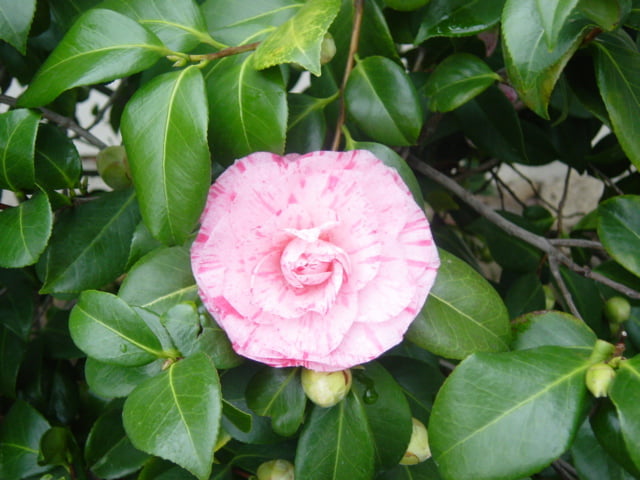
Camellia double-flowered cultivar
But, if you want to cast your net further; camellia flowers come in all shapes from anemone to peony, carnation, rose and water lily – and colours range from white through to yellow to pink and red. There are striped flowers like the red and white ‘Betty Foy Sanders’ and the picotee edged ‘Tom Thumb’. Although they are best known as spring flowering evergreens, they actually flower at different times: from autumn through to early summer.

Frost hardiness is the big issue with camellias. There are some that have to be grown in a cool greenhouse but there are plenty of perfectly hardy types for the garden, especially Camellia japonica varieties and some of the hybrids like Camellia x williamsii. But, sun and wind on frozen plants is particularly damaging – especially to buds and flowers. In the North, plants struggle to survive outdoors – although, there is hope on the horizon as new extra cold-hardy, free-flowering cultivars are on their way. In the meantime, very cold winters have to be braved with a thatch of straw or a duvet of bracken – or plants have to be grown in a pot and laboriously dragged inside.
The good news is that damaged growth is very keen to grow back and camellias can even be hard pruned.

Camellia x williamsii
Camellias mostly need partial or dappled shade making them ideal for growing under trees – which will also protect them from early morning sun, cold winds and late frosts. Some like Camellia x williamsii ‘Donation’, an erect, compact shrub with large semi-double pink flowers, does noticeably better in partial shade when flowers are deeper in colour and last longer. Camellia japonica varieties need protection from the midday sun or they can look pale and dull but Camellia sasanqua will thrive in sunshine once they are established.
In other ways, camellias are as tough as they come and suffer from only a tiny minority of troublemaking pests. Honeydew, produced by scale insects and aphids, attracts black sooty mould, which doesn’t actually harm the plants and can be sponged off smaller specimens – and the insects removed by hand. If you are going to spray larger plants for scale the best time to do it is in July. An increasing problem though is vine weevil, particularly for container-grown plants where larvae eat young roots and sometimes strip the bark at soil level. Fortunately, there is an ever-increasing range of weapons of mass vine weevil destruction, but probably the best is a late summer application of nematodes.
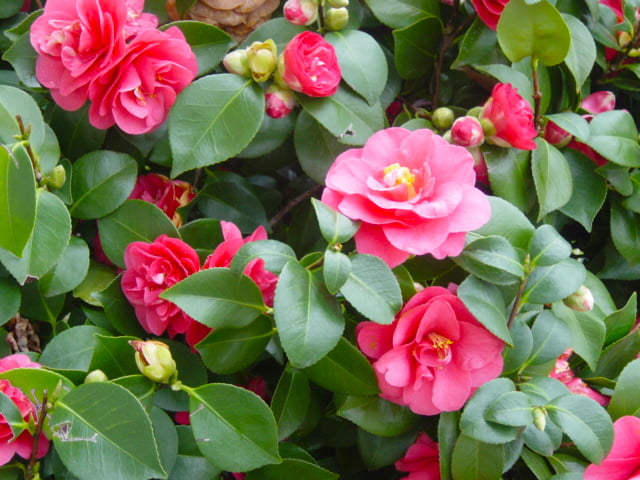
Camellia semi-double cultivar
Up until now, camellias have suited our climate pretty well – but they prefer to be dryish in winter and then have plenty of moisture during the growing season. This is crucial for the buds to swell from midsummer until October, as dryness of the roots at this stage can cause the buds to drop off when the cold weather sets in.
The problem now and for the future is that our winters are getting wetter and our summers drier which isn’t ideal.
Containers may be the way forward, especially if you can’t otherwise provide the free-draining acidic soil and organic matter they crave, but my worry is that I wouldn’t water them regularly enough to stop the buds falling off, so automatic irrigation could be the only answer.
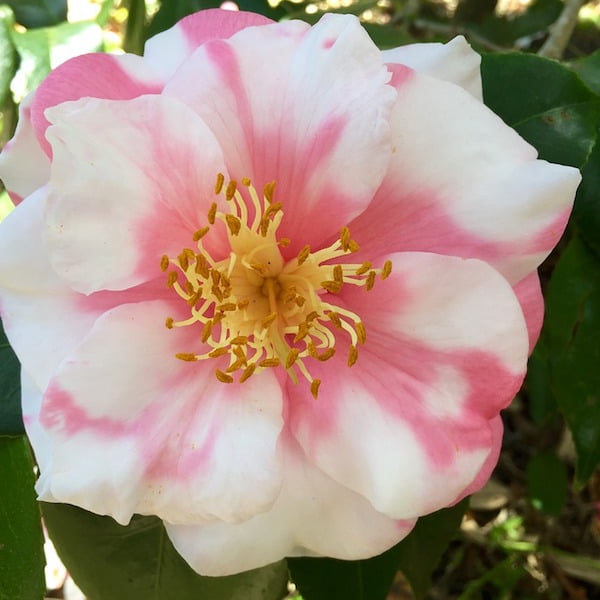
Pink and white Camellia japonica ‘Clothilde’
Peat-free soilless composts aren’t recommended, but the John Innes ericaceous mixes are a low-peat alternative, and adding sharp sand or grit will improve drainage and provide important extra weight to stop them toppling over on windy days.
Whether in the ground or not, camellias must never be planted too deep or overfed. A granular ericaceous fertiliser can be sprinkled over the soil when the plant starts growing in spring, and then again in July when there is a second burst of growth – but only use about half the recommended amount. Nutrient deficiency, usually indicated by discoloured leaves on ground with a pH of 7 or higher, can be cured with a dose of Sequestrine, but I am still puzzled as to why the camellia I inherited in my own garden seems to be thriving on my alkaline soil without any help at all. Some plants are a mystery!

Camellia japonica
CAMELLIA TYPES
Camellia japonica
Camellia japonica is the most common of the Camellias, giving rise to some of the most beautiful varieties – of which there are more than 20,000. They are long-lived upright, spreading shrubs or even small trees – some up to as tall as 9 metres. The broad elliptic leaves (5-8cm long) are dark green, very glossy and evergreen – making these plants very attractive even when not in flower. The flowering period itself is mainly mid-to-late spring, but some varieties will already be in flower come late autumn.
Camellia japonica ‘San Dimas’ flowers from mid winter to early spring and has velvety dark red, semi-double flowers with golden yellow stamens at the centre. The leaves are very dark green and very shiny and being narrow and compact this relatively hardy shrub is extremely attractive even when it isn’t flowering.
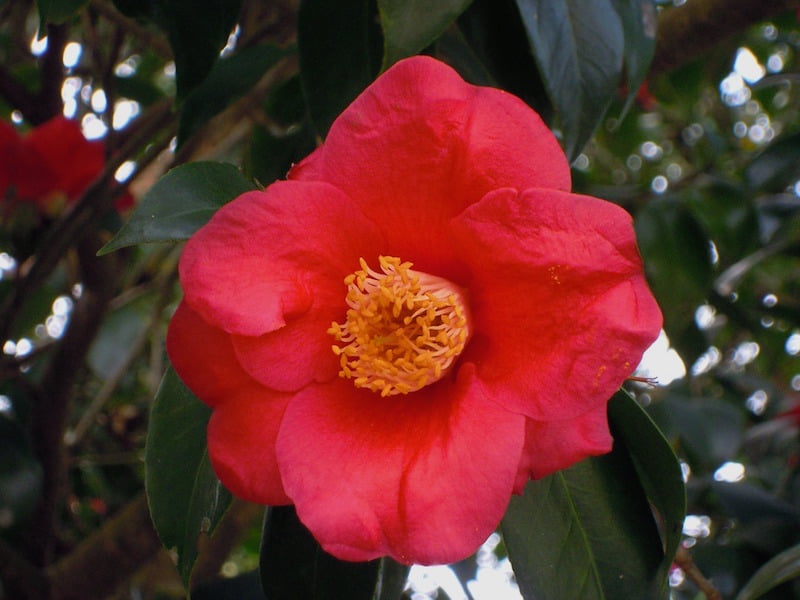
Camellia japonica ‘San Dimas’
HIGO CAMELLIAS
These are a type of Camellia japonica, some of which were created many centuries ago in a region of Japan. They have flat, wide-open flowers that thrust forward the central powder puff of yellow stamens. Most varieties have a delicate scent and poetic names that translate to things like ‘Harbour of the Rising Sun’ or ‘Sanctuary of Happiness’
‘Hiodoshi’ flowers from mid to late spring, with scarlet petals and a wide cluster of golden yellow stamens. It is very hardy.
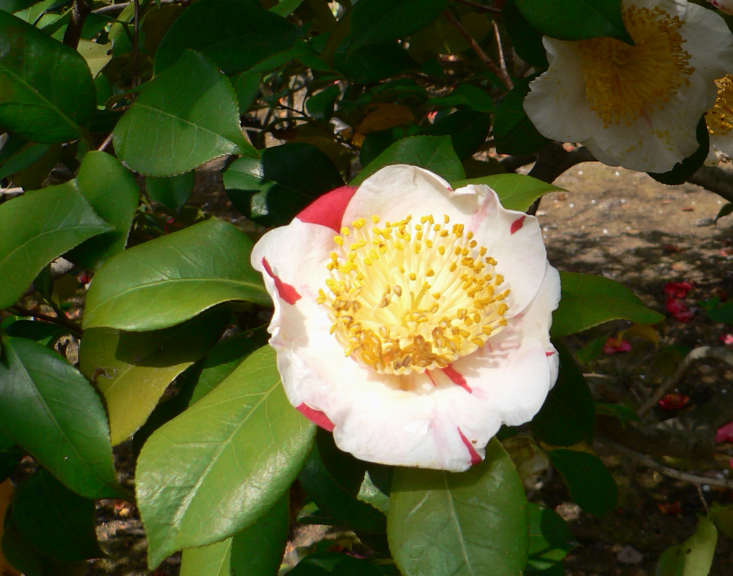
Higo camellia. Photo Hisagi (氷鷺)
Camellia x williamsii
Camellia x williamsii is a hybrid between Camellia japonica and Camellia saluensis – produced in this country with leaves that tend to be like the former, and profuse flowers that take after the latter. Most will usually flower between mid to late spring.
Camellia x williamsii ‘Brigadoon’ is an open, rounded shrub with very large, semi-double rose pink, silver-tinged flowers, with broad downward curving petals.

Camellia x williamsii ‘Brigadoon’
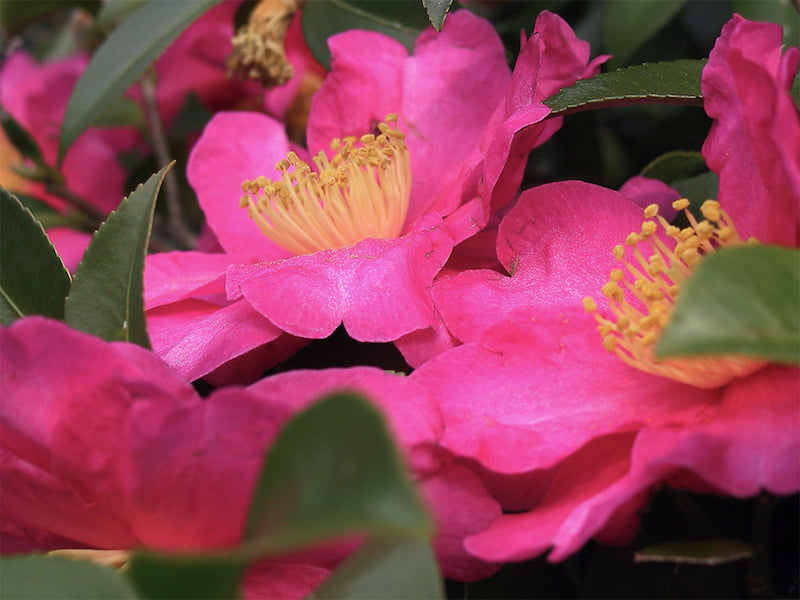
Camellia sasanqua ‘Shishigashira’
Camellia sasanqua
Camellia sasanqua flowers are not quite as hardy as Camellia japonica, but are possibly even more beautiful. Generally the flowers and leaves are more delicate than the camellias familiar to most of us, and they flower profusely over a long period – although the individual blooms don’t last long, and do drop off. Some start flowering really early – around September or October – and many have a delicate spicy scent.
Camellia sasanqua ‘Shishigashira’ has small semi-double or rose-shaped pinkish red flowers.
SCENTED CAMELLIAS
When it comes to scent – the largest, most common groups of camellias (the ordinary Japonica varieties and Cameliia x williamsii) are almost a total dead-loss, apart from a few exceptions – which are wonderfully scented. As a general rule, all the wild species of Higo camellias have a delicate scent, and all sasanqua camellias release a fresh spicy aroma.
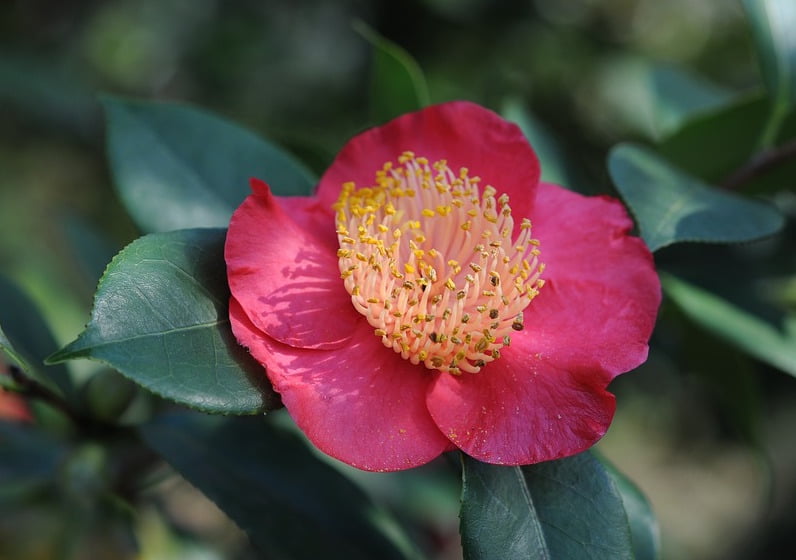
Higo camellia
Camellia lutchuensis is a spreading shrub or small tree 2 or 3 metres high, with strongly scented single white flowers.
Camellia japonica ’Odoratissima’ is one of the few scented japonicas and has a rose red double flower like a peony.
Camellia ’Duftglockchen’ has a light pink single flower with a cluster of yellow stamens at the centre. It flowers profusely with a sweat pleasant scent.
Camellia ‘Yuhsienensis’ is a rounded shrub or small tree with dark green leaves and small, highly fragrant, single white flowers.
Camellia sasanqua ‘Narumigata’ is a tall thin shrub reaching about 4 metres with small, fragrant, single white pink tinged blooms.
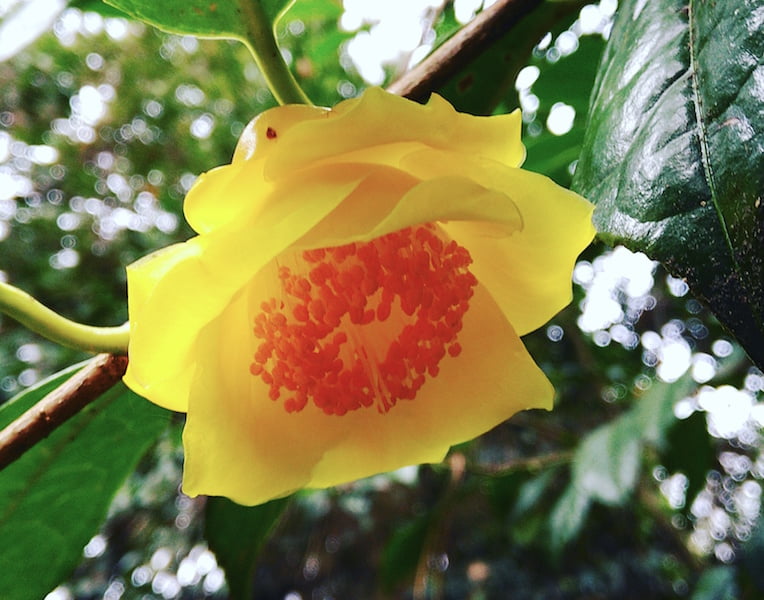
Camellia nitidissima
Camellia nitidissima is one for a warm humid greenhouse, but produces unique pure yellow flowers, which are fragrant.
Higo Camellias are a distinct group of Camellia japonica with flat wide open flowers, with large clusters of fluffy yellow stamens and most have a delicate scent.
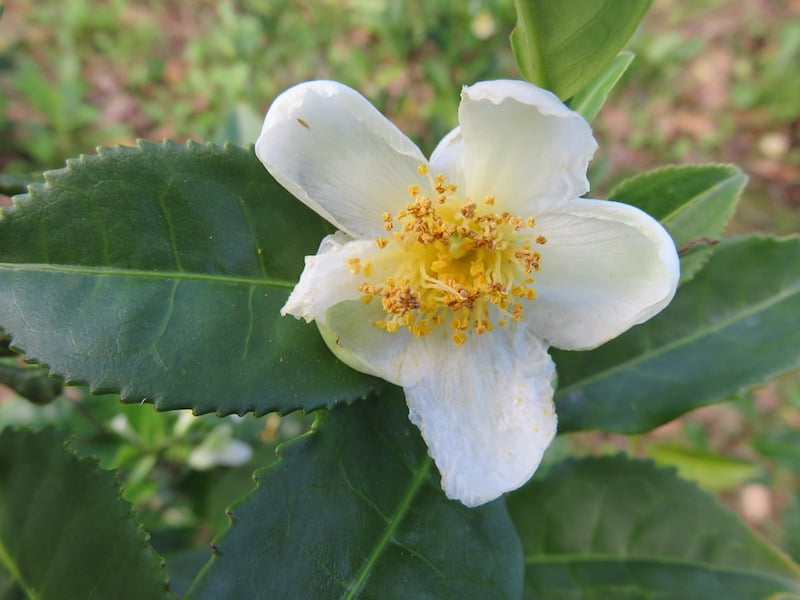
Tea flower – Camellia sinensis
TODAY’S ‘MUST PLANT’ CAMELLIA
Camellia sinensis – Assamica, Tea
Why?
There’s a bit of a back-to-nature trend among camellia growers to get away from the large showy blooms that have been bred over the years. This camellia fits the bill nicely, as it has small delicate white flowers (2.5cm across) with a cluster of yellow stamens and a spicy fragrance.
Where?
These are good plants for a pot or large container, and are hardy down to -10C, so may need protection of a cool greenhouse in colder areas. They also benefit form plenty of summer sun.

Camellia sinensis, the tea plant
When?
The flowers appear from mid autumn to mid winter. If you want to make a cup of tea then you’ll need to pick the fresh new leaf growth regularly in late spring and early summer, but it’s easier to buy tea bags.
Tell me more?
They are a bit fussy when it comes to soil requirements, (need a pH of 6.5). In late spring and early summer, apply liquid fertiliser at half strength.
History
Samuel Pepys had his first cup of tea in 1660, but at £3.50 per lb. it was too pricey for the masses, and didn’t catch on until the 18th Century. Originally from China, Tibet and Formosa -tea then was shipped to India and Sri Lanka by the British, who now drink over 180,000 tonnes every year!
Article provided Andy Sturgeon Garden Design.
